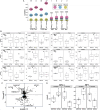Simultaneous RNA Sequencing and DNA Methylation Profiling Reveals Neural Mechanisms That Regulate Sensitive Period Behavioral Learning
- PMID: 40776851
- PMCID: PMC12332422
- DOI: 10.1111/gbb.70031
Simultaneous RNA Sequencing and DNA Methylation Profiling Reveals Neural Mechanisms That Regulate Sensitive Period Behavioral Learning
Abstract
Developmental processes emerge from both maturational and experience-dependent mechanisms. Experience at the proper maturational stage is essential for the acquisition of many complex cognitive and behavioral processes. A striking example of this is a critical period, a restricted developmental phase during which experience is required for both behavioral acquisition and period closure. Juvenile male zebra finches (Taeniopygia castanotis) possess a critical period for song learning; hearing an adult "tutor's" song between posthatch days 30-65 is necessary for each male to produce a socially functional adult song. However, if tutor song is not experienced in this age range, juveniles can still learn beyond posthatch day 65. Our broad objective is to decipher the neurogenomic mechanisms that promote or limit the ability to learn, leveraging the known parameters of the critical period in the male zebra finch's sensory song learning ontogeny. Here, we manipulated juvenile males' tutor exposure and provided song playback experience at two ages, at the beginning or end of the critical period. We probed the relationship between DNA methylation and transcriptional profiles from the same individual and tissue samples to enhance interpretation across different levels of biological organization. Our findings uncovered specific genes and processes that may regulate aspects of critical period learning, as well as aspects of DNA methylation dynamics and how they correspond to RNA measures. Because we distinguished effects of age and experience, outcomes provide insight into fundamental links between epigenetic and molecular properties as the developing brain shifts its ability to learn.
Keywords: epigenetics; social ontogeny; songbird; song‐learning; zebra finch.
© 2025 The Author(s). Genes, Brain and Behavior published by International Behavioural and Neural Genetics Society and John Wiley & Sons Ltd.
Conflict of interest statement
The authors declare no conflicts of interest.
Figures



Similar articles
-
Vocal constraints on song amplitude in star finches Bathilda ruficauda.PeerJ. 2025 Jul 10;13:e19705. doi: 10.7717/peerj.19705. eCollection 2025. PeerJ. 2025. PMID: 40656944 Free PMC article.
-
Maternal behavior influences vocal practice and learning processes in the greater sac-winged bat.Elife. 2025 May 13;13:RP99474. doi: 10.7554/eLife.99474. Elife. 2025. PMID: 40356332 Free PMC article.
-
Early auditory and adult mating experiences interact with singer identity to shape neural responses to song in female zebra finches.J Neurophysiol. 2025 Feb 1;133(2):598-610. doi: 10.1152/jn.00504.2024. Epub 2025 Jan 8. J Neurophysiol. 2025. PMID: 39773075
-
PTS-Related Tetrahydrobiopterin Deficiency (PTPSD).2025 Jul 10. In: Adam MP, Feldman J, Mirzaa GM, Pagon RA, Wallace SE, Amemiya A, editors. GeneReviews® [Internet]. Seattle (WA): University of Washington, Seattle; 1993–2025. 2025 Jul 10. In: Adam MP, Feldman J, Mirzaa GM, Pagon RA, Wallace SE, Amemiya A, editors. GeneReviews® [Internet]. Seattle (WA): University of Washington, Seattle; 1993–2025. PMID: 40638773 Free Books & Documents. Review.
-
[Meaning and Mechanisms of Birdsong: Inspiration for Pneumology].Pneumologie. 2025 Jun;79(6):427-438. doi: 10.1055/a-2463-7380. Epub 2025 Jan 31. Pneumologie. 2025. PMID: 39889729 Review. German.
References
-
- Lorenz K. Z., “The Companion in the Bird's World,” Auk 54, no. 3 (1937): 245–273.
-
- Mariette M. M. and Buchanan K. L., “Prenatal Acoustic Communication Programs Offspring for High Posthatching Temperatures in a Songbird,” Science 353, no. 6301 (2016): 812–814. - PubMed
-
- Meillère A., Buchanan K. L., Eastwood J. R., and Mariette M. M., “Pre‐ and Postnatal Noise Directly Impairs Avian Development, With Fitness Consequences,” Science 384, no. 6694 (2024): 475–480. - PubMed
-
- Hess E. H., “Imprinting, an Effect of Early Experience, Imprinting Determines Later Social Behavior in Animals,” Science 130, no. 3368 (1959): 133–141. - PubMed
-
- Hensch T. K., “Critical Period Plasticity in Local Cortical Circuits,” Nature Reviews Neuroscience 6, no. 11 (2005): 877–888. - PubMed
MeSH terms
Grants and funding
LinkOut - more resources
Full Text Sources

